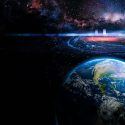The World Health Organization estimates that up to 320,000 people die by drowning every year, not to mention those eaten by marine creatures. Today, we’ve put together a list of the top five most dangerous places to swim in the world, and how to survive them.
Pay attention, so you don’t become another statistic. Where do most shark attacks occur? What’s the deadliest lake in the world? And how has one place earned the nickname of “Diver’s Cemetery”?
Number 5: Lake Victoria, Africa
It’s Africa’s largest lake. Its coasts touch Tanzania, Uganda, and Kenya. And as the Nile River’s chief reservoir, Lake Victoria is essential to millions of people’s lives, but it’s also known as the world’s “most dangerous lake.”
Because of its warm waters, 80 m (262 ft) maximum depth, and there is so much moisture, it generates convective potential energy, erratic weather, characterized by a lot of cloudiness, heavy thunderstorms, and strong waves. The boats the fishermen use can’t withstand the high waves and storms.
Also, they are generally overloaded, many fishermen can’t afford life jackets, and some fishermen don’t know how to swim. All of this results in up to 5,000 deaths every year, according to local officials. If you plan a trip to Lake Victoria, avoid overloading the boat, don’t stray too far from shore, and wear a life jacket.
Number 4: The Blue Hole, Egypt.
It’s 120 m (393 ft) deep, slightly less than the Great Blue Hole in Belize, but this sinkhole has earned the nickname of “The Diver’s Cemetery.” Experts say it owes the name primarily to the arch and the underwater tunnel in it. It’s 56 m (185 ft) from the surface, so people think they can reach it with recreational diving equipment.
As they swim deeper and deeper, the oxygen in the compressed air they breathe becomes toxic. And they get nitrogen narcosis from the increased nitrogen. Finally, the divers may discover too late that they are not using the necessary equipment.
There’s no record of how many people have died at the Blue Hole, but some expert divers think it could be up to 200. If you find yourself snorkeling or diving here, please, leave your ego on the shore, and be properly equipped. ”
Number 3: Hanakapiai Beach, Hawaii
This fantastic beach, only accessible by the Kalalau (call-a-lau)Trail, is infamous for its killer rip currents that can sweep people 10 km (6 mi) away from the closest shore. It has been reported that in recent years, 83 people have been killed by these mighty currents. If a rip current grabs you,, the U.S National Oceanic and Atmospheric Administration advises you not to try to fight it. You’ll only get exhausted and drown. Go with it, and try to swim parallel to the shore. At some point, you’ll be out of the rip current. Then, swim back to the beach immediately.
Number 2: Volusia, Florida
According to the International Shark Attack File, Florida has more shark attacks every year than any other place in the world. Between 2011 and 2020, 242 unprovoked shark attacks were reported in Florida, almost a third of the total attacks worldwide.
And Florida has its own local champion. Volusia county has recorded the most attacks, with 320 total bites since 1882. If it’s too late and a Great White shark has spotted you, experts advise keeping eye contact with it.
That will make it feel less comfortable attacking you. And let’s hope it changes its mind. But if it doesn’t, fight back. A shark attacked Australian pro surfer Mick Fanning during a competition in South Africa. He kept yelling and punching the shark on the nose until the shark released him and he was able to return to shore.”
Number 1: The Boiling Lake, Dominica
This 60 m (200 ft) wide lake is a volcanic crater filled beneath by underground streams and rainwater. The volcanic gases that the crater erupts heat the water up to 92ºC (197ºF).
But from time to time, the temperature and the water level drop, and some tourists venture to the water. In 1900, the lake had stopped boiling for a month, and a group of tourists ventured to the crater to take a look.
Suddenly, the crater erupted a belch of sulfurous gas, knocking out two of the visitors, who fell to their boiling death. Some years ago, the lake stopped boiling again, and some people have been seen swimming in its warm waters.
But experts say that it’s just a matter of time until the lake suddenly starts boiling again. So, please leave the floaties at home when visiting this place.
Sources
- “Drowning”. 2021. who.int.
- “Lethal weather on ‘world’s most dangerous lake'”. CNN. From Errol Barnett, CNN. 2021.
- “Lake Victoria Bathymetric Map v7.0 (LVBM)”. faculty.salisbury.edu
- “Top diver’s death casts long shadow over deep beauty of the Blue Hole”. 2017. The Guardian.
- “What It’s Like To Dive The World’s Deadliest Dive Site”. Wilson, Breanna. 2021. Forbes.



























